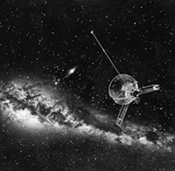
Pioneer 10 becomes the first human-made object to pass outside Pluto’s orbit.
Pioneer 10 is one of the most successful spacecraft of all time. Designed for deep-space exploration, which at the time of its launch, in 1972, meant pretty much anything beyond the moon, Pioneer 10 achieved a number of firsts while sending back valuable data. Among the milestones:
| • | A breakaway speed of 32,400 mph, making it the fastest human-made object to leave the earth. It shot past the moon in just eleven hours and crossed Mars’s orbit in twelve weeks. |
| • | First spacecraft to pass through the asteroid belt |
| • | First direct observations and close-up images of Jupiter, which confirmed that the solar system’s largest planet is mostly liquid |
| • | Clearing Pluto’s orbit, considered the boundary of the planetary solar system before astronomers deplanetized Pluto (see here) |
| • | Continuing to send back data regarding solar wind until its scientific mission ended, in 1997 |

Attempts to contact Pioneer 10 were terminated following the spacecraft’s last transmission of telemetry data, on April 27, 2002. Nevertheless, NASA’s Deep Space Network received a final, faint signal on January 22, 2003. It’s been silence ever since.
Although lost to contact forever, Pioneer 10 continues its journey through interstellar space. It’s headed in the general direction of Aldebaran, the brightest star in the constellation Taurus, forming the bull’s eye. According to NASA, it will take about two million years for Pioneer 10 to reach Aldebaran.
So Pioneer 10’s mission, originally intended to go twenty-one months, lasted twenty-five years and change. As project manager Larry Lasher said, “I guess you could say we got our money’s worth.”—TL